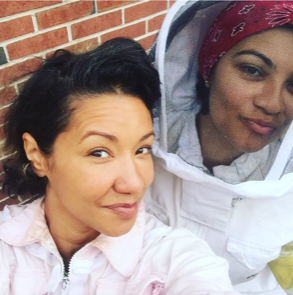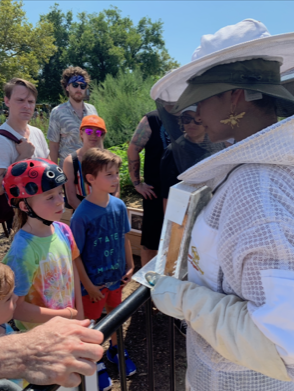Stacey Vazquez: Beekeeping as a Family (& Urban) Affair

Stacey Vazquez is one half of the dynamic duo that runs Island Bee Project on Governors Island in New York City. Along with Carolina Zuniga-Aisa, Stacey manages the 7 hives on the island, which is also home to the GrowNYC garden program and the Earth Matter farm. Stacey and Carolina met at a beekeeping class at the Brooklyn Grange and became fast friends and co-bee nerds.
They started out working on Earth Matter’s (a compost learning center) farm for about two years and on their third year, the Trust for Governors Island contacted them to offer a dedicated space for their beekeeping. In 2019, Island Bee Project partnered with the Honeybee Conservancy and Stacey and Carolina moved again into the space they currently occupy.
In addition to providing education on honey bees, part of this partnership includes encouraging people to learn a bit more about the native bees that exist in New York as well. They continue collaborating with folks at the Brooklyn Grange and are always meeting new beekeepers in New York City. “I’m always super shocked at how small, yet huge that community is,” says Stacey.
And with the Honeybee Conservancy, the Island Bee Project works with some other beekeepers as well. “We’ve done some on-site fairs at community farms in the Bronx,” says Stacey, and in addition to all the education provided, they also support community through social media.
Like the other urban beekeepers interviewed, Stacey mentioned one of the challenges to beekeeping in the city is having enough forage for the bees. She recounted a story of one season where the bees went in search for something to eat that was not good for them – runoff from a nearby maraschino cherry factory. And they learned an important lesson that year to make sure the bees had sufficient food ever since.
Aside from that, there are many reasons why “New York City is an interesting place to keep bees,” says Stacey. People get creative with use of space. “We have friends that keep bees in cemetaries…on rooftops, backyards, and city parks. There’s room available but you really do have to seek it out.”
As self-proclaimed “lady beekeepers” with Latinx backgrounds, neither Stacey nor Carolina has had any big issues in the larger beekeeping community, but Stacey admits it is largely a “boys’ club” still. However, “there’s a big community of women and lady beekeepers in New York City [and that] community is building, but we were always really surprised when we went to conventions – it’s a pretty one kind of group deal.” While conventions have in the past consisted mostly of old white men, “they’re [often] farmers and it’s amazing talking to them,” says Stacey. “It’s always really cool hearing their stories and meet[ing] somebody who has like 40 years of beekeeping experience.”
At the first convention they went to in the Berkshires in western Massachusetts, “everybody from class [at the Brooklyn Grange] – city kids rented a car, we drove out there and when we got out in a big field…it was gorgeous…but when we walked in, we were definitely the most varied group there. At first, I’m pretty sure they were like, whoa, what are these folks doing here? What are these city kids doing here?”
“We definitely stuck out like sore thumbs. But at the end of the day, it was a great experience because everyone has the same goals in common and once people see that you’re really interested in this cause and helping bees and keeping them alive, people just kind of stop seeing what you are, they see who you are.”
Stacey thinks the beekeeper landscape is changing because “times change” and “I like to think this generation is becoming a little more conscious of what’s going on in their environment and things that need to change.” Stacey sees that “young people of all ethnicities and walks of life are really involved.”
And young people of all ages have taken interest in bees and beekeeping. “We love working with kids,” says Stacey. “When we do work with the Honeybee Conservancy, we go to different neighborhoods and talk to a whole class of kids.” One of the special things about this is when Stacey and Carolina talk to the kids about bees, they emphasize “how every job that they do is meant to help the hive as a whole. Everything is done for the greater good of the hive. It teaches children a less selfish view of how you should live your life even though you’re not a bee.” Kids learn that everybody has a job to do.
And beekeeping has become a family affair for one family that’s contacted them. A friend of a friend wanted to start a rooftop garden in her building and wanted to involve her two children (ages five and seven at the time) in the whole process. Stacey and Carolina split one of their hives, drove it over to Park Slope, Brooklyn, and the rest is history.
“We raised a beekeeping family in Brooklyn,” says Stacey. “They’re all beekeepers, and we still kind of mentor them when stuff goes on, if they have questions, and the mom comes out when we need volunteers and the kids come too. That was a really awesome thing [that] we taught a whole family how to keep bees.”

Stacey finds New York City a unique place to be a beekeeper. “It’s definitely a special community of people who want to cultivate a natural environment within the urban environment” and beekeeping is “not the first thing you think of somebody doing in the urban metropolis of the country.”
In terms of beekeeping philosophy, the Island Bee Project avoids chemical treatments, opting for natural intervention for , and “we try to keep it as minimally invasive as possible.” Like Alwyn of Oxx Beekeeping, Stacey and Carolina also use essential oils to keep mite count down and they also use formic acid.
Stacey mentioned a beekeeper in New Jersey who is raising “behaviorially hygienic bees” and this is something she hopes becomes a more mainstream practice “for people to be raising these kind of bees because they’ll either attack the varroa mites and bite their legs off so that they can’t attach to the bees, or they groom each other and take them off.”
“We’re aligned with the natural beekeeping philosophy,” says Stacey. “Our goal is definitely to get to a point where we don’t have to [treat them at all] but for sustainability reasons [minimally invasive and non-chemical treatments – and feeding – are needed so as] not to have to replace everything all the time.”
Media Attributions
- Stacey Vazquez and Carolina Zuniga-Aisa © Stacey Vazquez is licensed under a All Rights Reserved license
- Stacey Vazquez and youth group © Stacey Vazquez is licensed under a All Rights Reserved license
Varroa destructor (Varroa mite) is an external parasitic mite that attack and feeds on the honey bees Apis cerana and Apis mellifera. The disease caused by the mites is called varroosis. The Varroa mite can only reproduce in a honey bee colony.


Feedback/Errata